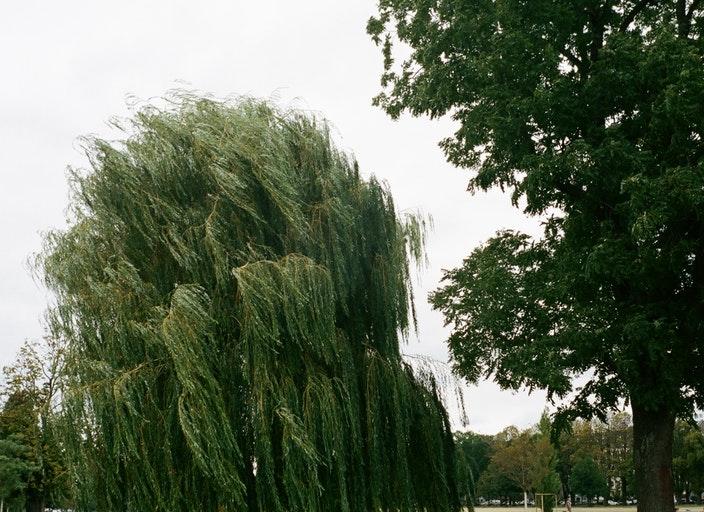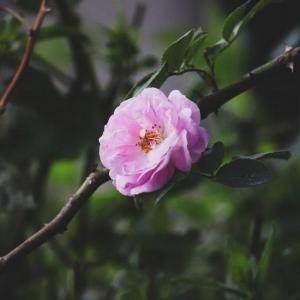
Due to its contributions to medicine, one may claim that Salix alba is one of the most significant trees in human history. The ingredients required to create aspirin and other medicinal items have been made available to the globe by white willow. Even though Salix alba is a stunning tree, one of its cultivars is typically preferred for horticultural purposes instead of the straight species. As a result, it is often difficult to obtain wild-type white willow trees in the nursery industry. Only the species cultivars should be taken into consideration if you want to include the species in your landscape design. The species cultivars are great additions to wet locations and places that may be on the moist side, like the border of a rain garden, keeping that caution in mind.
Care for White Willow
White willow trees need a lot of work to maintain, which is one of the reasons they are often avoided. Owners of S. alba trees are always on the lookout for indicators that their tree may have a problem or be causing harm to their infrastructure due to the multiple problems the species faces. It is particularly foolish to plant this tree close to buildings, pipelines, cesspools, or sidewalks because of its shallow, invasive roots. You could find yourself caring for the white willow more often than appreciating its beauty due to the leaf and blossom debris that makes it untidy and the fragile, damage-prone wood that tends to collapse with the least wind and ice stress. Additionally, it only lasts for around 20 years before it begins to disintegrate.
If you currently own a white willow, you may read about how to care for it below. If you decide to buy a new tree, however, you're better off looking for a natural tree with the same traits or one of the cultivars.
Light
The health of your tree depends on where in your landscape it is located. In the shadow, white willows do not thrive. Your willow will thrive in a bright, sunny location where it can get lots of light, but you should give it at least partial sun exposure.
The kind of soil you use to plant your willow tree or the soil it is currently growing in will have a significant impact on how healthy it becomes. The ideal soil should be well-draining, moderately rich, and able to retain a significant amount of moisture. The white willow likes wetness and can withstand floods, but it cannot survive soil that is allowed to dry up. As a result, its ability to convey moisture is superior than its capacity to tolerate drought.
Except in cases when the soil is very acidic, soil pH is seldom a major problem. When it comes to pH levels, the white willow can withstand a relatively wide variety of situations.
Water
The most crucial component for keeping your white willow healthy and happy may be water. For its survival and growth, the species Salix alba requires an abundance of water. If your tree is situated in the optimal situation, the usual advice to ensure water is adequate while it is establishing itself then let it fend for itself applies here. Otherwise, it does not. If you put it somewhere that receives a lot of water naturally, that will assist. For this reason alone, planting a white willow next to a rain garden is a fantastic idea. The most crucial thing to understand is that, once established, white willows may withstand excessive watering, but they cannot endure prolonged droughts. If there isn't any water, the tree's roots will look for a supply, and if your pipes or sewage are nearby, you may have some problems.
Thermodynamics and Humidity
The white willow prefers a temperate temperature, preferring a colder environment versus one that is heated. Your willow tree will be among the last to lose its leaves and among the first to sprout new leaves in the spring, as you'll observe. USDA zones 3 through 8 are the range of Salix alba; outside of these zones, the tree cannot thrive.
Fertilizer
It is not a good idea to boost the fertilizer you give your white willow. This particular species' wood is already known to be fragile and brittle, so any fertilizer that can hurry branch development and result in wood that is even more fragile due to rapid growth would just exacerbate the problem. Test the soil if your tree looks to be having problems, and only then, if a deficit is discovered, should fertilizer be used as necessary. Fertilizing won't likely be necessary since the problem will likely be something else.
White Willow Types
Because of its many problems and harm to the property, using straight species S. alba in residential landscaping is discouraged, as was already indicated. When S. alba is a need, these cultivars are often chosen. Remember that although the hazards associated with straight species are reduced, they are not eliminated, and often, an alternative is preferable for the garden and the local environment.
Salix alba 'Vitellina' is a cultivar that is cultivated for its shoots, which are initially golden-yellow before becoming brown. Winter is a beautiful time to see it.
Salix alba "Tritis": a variety with a narrower crown, a rounded crown, and main erect branches from which dangle delicate, pendulous branchlets of golden foliage that may reach the ground.
The cricket-bat willow, Salix alba 'Caerulea,' is defined primarily by its growth type, which is quick-growing with a single straight stem and significantly bigger leaves that are more blue-green in hue.
Salix alba "Belders," a male cultivar with a small oval crown and a trunk that is either straight or beautifully curved, is often used for pollarding.
Pruning
Pruning a white willow involves exercising caution. The biggest challenge will be cutting weak, damaged, and dead branches. It has a lovely shape that is somewhat drooping, albeit less so than Salix babylonica (Weeping willow), that you want to keep. When a tree is young, trimming is simple; it should be done every year in the autumn after the leaves have fallen. Pruning as needed will elevate the canopy from the inside while allowing the exterior to droop. This species may have more than one leader. Plan to move around beneath the tree while making your cuts, disregarding the outside border to create a drooping habit. Only maintenance pruning, such as removing dead wood, branches that cross other branches, and broken branches, will be done on the outside border. It will be time to hire a qualified arborist to do the pruning when the tree becomes too big for you to properly prune from the ground using hand tools.
Propagation
Although planting and growing the white willow as a straight species in a garden is strongly prohibited, it is achievable via cuttings. Taking softwood cuttings in late spring or early summer is the simplest way. You must do the following in order to take softwood cuttings:
1. Early in the morning, trim four inches of fresh growth above a bud on the parent plant.
2. Put the trimmings in a fresh plastic bag.
3. To make your cut, trim below a leaf node using a sharp knife.
4. Take off the lowest leaves, then cover the cutting's base with a hormone that promotes roots.
5. Insert the cutting's base into a container filled with soilless mix, keeping the top two leaves slightly visible. Wet the mixture.
6. Put the pot with the cutting in a propagation box, cover with a plastic bag, spray once every two weeks, and put in an area with indirect light.
7. Continue to maintain the soil's moisture until roots appear.
8. Prepare your freshly rooted willows for the world (2-4 weeks).
Typical Pests and Plant Illnesses
White willows are prone to a number of illnesses and bug issues. The majority of insects are only a nuisance and do not really pose a threat. The aphids, scale, borers, and lace bugs are the most frequent pests you may encounter. Since your tree serves as a vital host for several butterfly species, you carefully investigate chemical remedies as a remedy even if they pose no actual harm.
White willows are susceptible to anthracnose, crown gall, black canker, and blight, all of which can be problematic if left untreated. But thankfully, all of these may be avoided by maintaining your trees properly and using hygienic tool maintenance techniques. Between each tree, disinfect your pruning tools with alcohol or a bleach solution, and dispose of any yard debris appropriately.
文章
还没有人评论,快来抢沙发!









